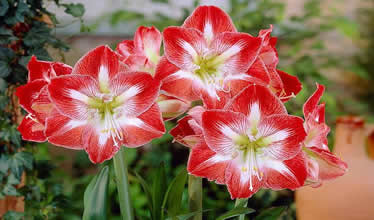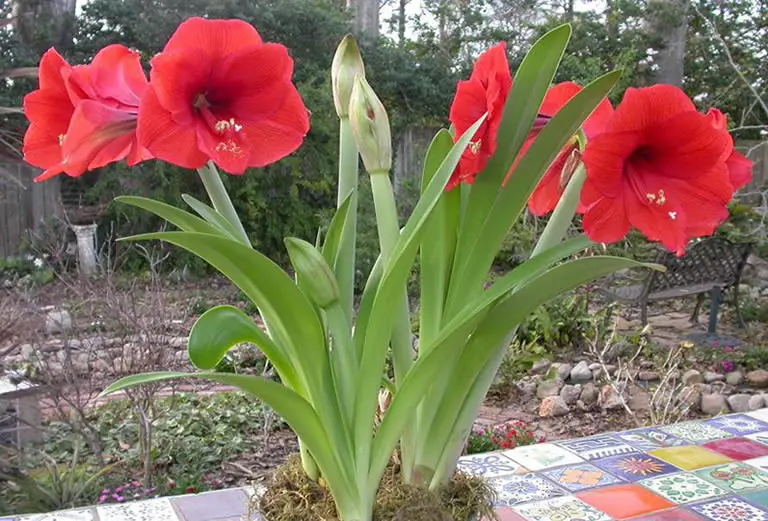Amaryllis is an easy-care succulent that is most often grown as a houseplant. With minimum care requirements this beautiful perennial comes in a wide range of varieties with multiple colors and bloom times. But many would-be amaryllis growers wonder how this plant blooms and if there are ways to get it to bloom even better. So, in this article I will cover both these subjects so you can get the most from growing amaryllis.
Table of Contents
How amaryllis naturally blooms
So how does amaryllis bloom?
Amaryllis is a perennial that naturally blooms once per year. It has an 8 – 12 week growth cycle from the end of dormany to full bloom. Amaryllis has a natural spring bloom time though it is possible to regulate the plant’s growth cycle to force the bulb to bloom in any month you wish.
Amaryllis are perennials. This includes both amaryllis proper and those variations of the genus belonging to the family Amaryllidaceae that are sold as amaryllis but are not actually amaryllis – read this more information on that. This means all plants marketed and sold as being amaryllis will flower once per year.
Amaryllis is a long-lasting plant with a very long life-span. Amaryllis will live for many decades if it is not neglected and given even just minimum care.
Amaryllis has a fairly short growth cycle.
All amaryllis plants follow the same 8 – 12 week growth cycle as follows:
- An amaryllis bulb leaves dormancy and starts a new growth cycle.
- New foliage growth starts with sprouts forming from the top of the bulb.
- Leaves will form from the sprouts and will fully mature over an 8 week period.
- During the initial growth stage the stalks that produce flowering bulbs may also form. However, it may take up to another 8 weeks, from the point of leaf maturation, for stalks to sprout.
- Stalks and leaves have the same growth cycle of 8 weeks.
- The reason some amaryllis will bloom within 8 weeks while others take up to 12 weeks is because the flowering stalks may sprout at different times to the leaves. Leaves also sprout with the new growth stage but stalks may not. Stalks may not sprout until the leaves have reached maturity.
- So, an amaryllis can bloom at any point from week 8 to week 12 depending on when the bulb produces it stalks.
- Once blooming has finished the bulb will enter dormancy.
- Bulb dormancy usually last 2 months but can last up to 3 months.
- After dormancy ends the growth cycle begins again.

Be aware that although amaryllis can go through its growth and dormancy stages more than once a year it will only bloom once per year unless it is forced to rebloom. I do not recommend forcing amaryllis to rebloom unless you know exactly what you are doing. It is much better to simply have multiple plants with different bloom times.
I have found that taxing an amaryllis bulb and overworking it will lessen the lifespan of the plant. Healthy amaryllis can live for many, many decades and many an amaryllis has outlived the person who planted it.
Forcing an amaryllis bulb to work harder and more often that it was intended to do will only weaken your plant and there is really no need to do this when you can simply have another plant with a different bloom time.
Not only does having another plant with a different bloom time mean you avoid the risk of overworking an amaryllis bulb, it actually means much less work for you. All you have to do is first regulate when your amaryllis plants bloom.
You do this only once and then let nature take over, whereas making an amaryllis rebloom requires constant effort.
What’s more, regulating when an amaryllis blooms is very easy.
Because there are multiple variations of amaryllis available I strongly urge you to consider having 2 or more amaryllis in your home. Then by cultivating them so that they have different bloom times you don’t have to force one amaryllis to rebloom when it normally wouldn’t.
This way you can have your bi-yearly (or even constant) blooms without having to constantly mess with the growth cycles of your plant.
I have instructions for regulating amaryllis growth cycles so you can choose when the plant blooms in my Ultimate Guide to Amaryllis Growth Stages.
Don’t throw away those bulbs. Amaryllis bulbs rebloom every year
Many people new to succulents or bulbs wonder if amaryllis rebloom or if it is just a one-time deal?
Amaryllis rebloom every year. Although amaryllis only bloom once per year naturally, there are steps you can take to force reblooming in the same year.
As I mentioned above, it is possible to force an amaryllis to rebloom, for multiple yearly flowerings, but in its natural state amaryllis will only bloom once per year. Forcing amaryllis to rebloom is totally possible but although the plant will show no signs of strain when you do this properly, continuing this practice will lessen the lifespan of the bulb.
Again, I urge you to consider having 2 or more amaryllis in your home so that you can cultivate each for a different bloom time rather than forcing the same bulb to rebloom before its natural time. This way you have no need to force reblooming and instead can enjoy different amaryllis blooms, from different varieties of amaryllis, at different times of the year.
Many people use this approach so they have one amaryllis plant with a spring/summer bloom and another one that has a Christmas bloom. It is such a common practice for amaryllis owners to cultivate their plants for a December bloom that amaryllis is now known as the Christmas Flower and the Christmas Plant. Variations such as Carmen, Picotee, Snow Queen and Christmas Star along with the very popular Red Velvet are most popular for Christmas blooms.
If you are interested in growing amaryllis as a Christmas flower be sure to get the correct amaryllis and follow the instructions I outlined for a late December bloom here.
In their natural habitat amaryllis bloom once per year
So how many blooms can you expect from amaryllis?
Amaryllis blooms once per year but it is a perennial plant that blooms every year. Amaryllis can live for many decades and a healthy plant will bloom every year.
However, it is possible to force amaryllis to bloom more than once per year by regulating its growth and dormancy cycle.
The natural cycle of amaryllis between growth and bloom
So we now know that amaryllis is a perennial plant that will bloom only once per year as part of its natural cycle. But how long does it take amaryllis to bloom?
It takes amaryllis between 8 weeks to 12 weeks to reach full bloom. Only stalks contain flowering blooms and they take 8 weeks grow and to produce open flowers. Stalks on some plants may grow simultaneously with the leaves giving an 8 week bloom time or they may not sprout until the leaves have reached maturity, giving a 12 week bloom time.

Blooms may appear at any stage between 8 – 12 weeks depending on your particular amaryllis plant. Some plants will form their leaves and their stalks at the same time while other plants will only form stalks after the leaves have fully matured.
Of course it is also possible to have a plant that starts to grow stalks after the leaves have started growing but before they have matured.
Thus you can have one amaryllis plant that blooms after 8 weeks while you may have another one that blooms after 6, 7, 8, 9, 10 or 11 weeks and yet another that takes 12 weeks to bloom.
It doesn’t take too long to get to know the exact blooming time of your own plants and I use this knowledge to my advantage. By keeping some amaryllis bulbs in dormancy longer than others I am able to synchronize the bloom time of different amaryllis plants.
In a similar fashion I can also use the approach, of forced longer dormancy, to stagnate the bloom times of different species for a continual but different type of amaryllis bloom year-round.
For your convenience I have listed the main reasons for a non-blooming amaryllis below.
The 6 main causes for a non-blooming amaryllis
For most amaryllis plants that are not blooming the causes can be found in the following:
- You have an immature bulb.
- The bulb is overworked.
- The bulb is planted in the incorrect soil.
- The plant is receiving insufficient nutrients.
- There are incorrect temperatures in the environment at play.
- You are expecting a bloom in the the wrong season for your plant.
When you address the issues above most amaryllis plants will once again begin blooming.
However, there are some plants that just refuse to bloom even no there are no apparent problems. So below are the instructions you need to follow to get your amaryllis blooming.
How to get amaryllis to bloom even if it never has before
If you are having problems with an amaryllis plant that is not blooming then you should read this article that outlines the most common causes and their easy fixes.
7 steps to force amaryllis to bloom (or rebloom)
Forcing an amaryllis to bloom starts by first forcing the bulb into a dormant state where it can rest.
Normally an amaryllis bulb requires very little attention after blooming has finished and it begins its dormant phase.
When an amaryllis bulb enters dormancy it just needs to be left alone for 2 months to ensure new growth and a vibrant healthy future bloom, (you can get more information on that in the article what to do with amaryllis bulbs after they bloom). But, if you have an amaryllis plant that has been well-cared-for and there are no obvious signs of injury or illness in the plant then you can follow the instructions below for forcing your amaryllis to bloom.
Be aware though that if there are stalks growing from the bulb then you probably just need to be patient. Straight stalks carry the flower bud and you may just have a late blooming plant. Only follow the instructions below if you have an amaryllis plant that has no stalks and that has refused to bloom for you.
If you have an amaryllis that is falling over or showing signs of distress or one that has stalks but will still not bloom read the article highlighting the main reasons for amaryllis not blooming. That article also gives key actions steps to fix the problem.
Below I have given you a step-by-step guide to get any amaryllis to rebloom no matter how stubbornly it has refused to flower up to this point.

Instructions for forcing amaryllis to bloom:
Force dormancy:
- Remove the bulb from the soil and prune back all foliage so you are left with a bare bulb.
- Gently brush away all soil from the bulb.
- Place the bulb on kitchen paper or newspaper and put it in a dimly lit room.
- Ensure the room is cool but not cold. Temperatures between 55° – 59°F are ideal for prolonging dormancy.
- Leave the bulb in this environment for at least 2 months, though 3 months is preferable (unless new sprouts appear).
- During these months the amaryllis bulb will rest.
- You will know that the bulb has had sufficient rest when new sprouts appear.
Repot.
- After the designated rest period (no longer than 3 months) has finished, and even if new sprouts have not appeared, it is time to repot the bulb.
- Repot the bulb in a new, or well cleaned, pot with good drainage.
- Use a nutrient-rich potting soil, I find miracle-gro potting mix to be the best for amaryllis.
- Water the bulb well ensuring the soil remains moist but not drenched.
Position correctly.
- Place the potted plant in a well-lit area but away from direct sunlight.
- Common amaryllis are tropical and subtropical plants that require warmth to grow. So, keep temperatures between 60° – 90°F, though temperatures of around 70° – 75°F are optimum (this is the average household temperatures in the US).
Care guide.
- When foliage begins to grow from the bulb fertilize the plant every 2 weeks. There will be plenty of nutrients in the new soil already but amaryllis are feeders and you want to give your plant the best chance for blooming. So, adding additional fertilizer during the growth stage will help with this. Do not over-fertilize the plant or it may lead to leaf burn and other problems.
- Water the plant regularly ensuring the soil does not dry out. Amaryllis soil should be damp but not drenched. Let only the top 2 cms of soil dry before rewatering. Use your finger to gauge this. Stick your finger into the soil to the point of the first bend. Your finger should come out with very slight soil residue on it. If it doesn’t then the plant needs watering.
Pre-bloom and during bloom.
- Look out for stalk growth as these carry the buds for flowering.
- When individual flowers have completed blooming and start to die deadhead them so resources are directed to new growth.
- If this is a plant that has never bloomed before I suggest you avoid cutting the flowers for vase-use, or for propagation, on this first bloom. Just allow the plant to follow its natural cycles with interference for at least its first bloom.
After blooming.
- When blooming has finished stop watering the plant and do add any more fertilizer.
- The bulb will begin to enter dormancy.
- Although an amaryllis bulb does not require darkness to rest during dormancy I would advise you move this particular plant to the same cool and dimly lit environment you stored the bulb in during its dormancy. This is probably not entirely necessary but it will ensure the bulb definitely rests, thus ensuring another bloom next season. You can also remove the bulb from the pot and store it as you did previously though this is not completely necessary. Keep the amaryllis there for at least 2 months.
After dormancy ends.
- When the dormancy period is over (you may see new growth forming from the tip of the bulb) you must repot the bulb.
- Remove the bulb from the pot.
- Clean the pot, or use a new one, and add new potting soil.
- Replant the bulb, water it and place it in a warm, well-lit area but away from direct sunlight.
- Water the plant.
- Then continue to water and fertilize the amaryllis as normal. See our amaryllis watering guide.
As you can see amaryllis are very easy to care for. And, even when you have a plant that is causing you problems, such as a lack of blooms, the fix is usually pretty simple.

